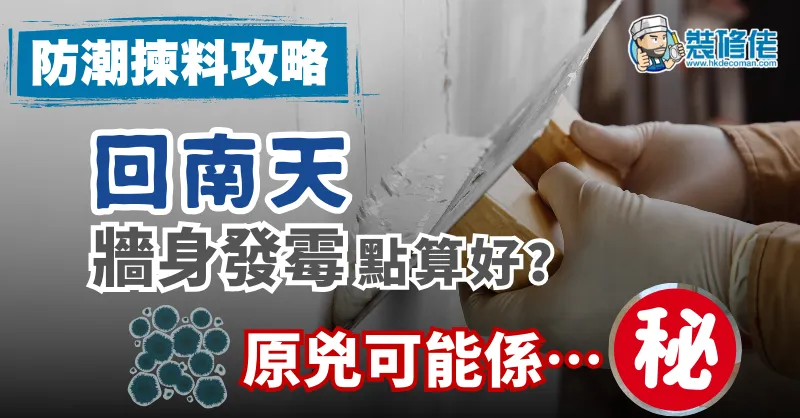Choosing the Right Wall Putty for Moisture Protection
Listen to the blog audio:

The 'Easterly Moisture' season is an annual 'humidity challenge' for many homes, with walls being particularly hard-hit. Issues such as mold, blistering paint, cracks, and peeling are common, and can even become breeding grounds for mold. Therefore, it is crucial to implement proper moisture-proofing measures during renovation, especially when selecting wall putty to ensure a solid wall base. This time, HKDecoman explores how to choose the right wall putty during renovation to create a durable and moisture-resistant home environment.
Wall Moisture Protection Goes Beyond Just Moisture-Proof Paint
Moisture protection isn't just about applying a layer of moisture-proof paint; it requires starting from the base layer of the wall and addressing each step carefully. The base plaster of the wall is the foundation supporting latex paint. If the base plaster isn't treated properly, moisture can lead to peeling, bubbling, or even mold growth on the topcoat, ultimately ruining the overall decoration. The goal of moisture protection isn't just to maintain the wall's appearance but, more importantly, to prevent mold growth. These molds can spread through the air, posing health risks such as respiratory infections and allergies.

Traditional Vegetable Fiber Putty vs. Ready-Mixed Putty
During renovation, wall plastering is an important step. Currently, there are two main types of wall plastering materials available on the market: "vegetable fiber putty" and "ready-mixed putty." The two differ in application methods, results, and moisture resistance.
Vegetable Fiber Putty (Vegetable Fiber Chalk)
Vegetable fiber chalk is a traditional wall plastering material in the renovation industry. It consists of vegetable fiber (plant fibers extracted from seaweed) and chalk powder, among other ingredients. During application, plaster powder, varnish, and white glue are often added, with these materials mixed on-site by the craftsman. The advantages of vegetable fiber putty are its lower cost and the ability for craftsmen to adjust the mixture based on their experience, resulting in a smooth and even wall surface after sanding, which provides a good foundation for subsequent primer and topcoat application.

However, vegetable fiber putty also has significant drawbacks. First, the mixing process heavily relies on the craftsman's skill, leading to relatively lower quality consistency and potential inconsistencies during application. The most critical drawback is that vegetable fiber putty can easily cause mold growth on walls. Since vegetable fiber is an organic material, prolonged exposure to humid environments can lead to bacterial and mold growth, resulting in moldy walls. Additionally, vegetable fiber putty has poor water resistance. When moist air penetrates the base layer, it can soften the putty, further weakening the adhesion of latex paint, causing bubbling, cracks, or even peeling. Therefore, while vegetable fiber putty is cost-effective, it is not durable in humid environments.
Read more: 【Home DIY】Complete Guide to DIY Painting – Easily Create Your Dream Home with Color
Compared to vegetable fiber putty, ready-mixed putty is a more eco-friendly and durable option. Ready-mixed putty is a pre-mixed plaster that only requires adding water during application, eliminating much of the on-site mixing process. Additionally, it contains no organic components, making it resistant to mold even in humid environments.
Compared to ordinary putty, many paint brands on the market have introduced their own wall fillers, which do not require dilution and are ready to use, making construction more convenient.


Various wall filling materials available for purchase
Advantages of Putty:
1. Waterproof and Mold-resistant
The main components of putty include hydrated lime (Ca(OH)₂), talcum powder, and glue. Hydrated lime reacts with carbon dioxide in the air to form calcium carbonate crystals, creating a waterproof layer that significantly enhances the wall's water resistance, making it less prone to mold and greatly improving the wall's durability.
2. Moisture-resistant and Breathable
Putty effectively resists humid environments while maintaining breathability, reducing wall problems caused by moisture.
3. High Adhesion
Putty has a smooth texture, which better enhances the adhesion of primer and topcoat, ensuring the overall stability of the wall surface.
4. Eco-friendly and Odorless
Unlike traditional materials like vegetable glue and whiting powder, which require the addition of pungent materials like varnish, putty is odorless and non-toxic, making construction more environmentally friendly.
5. Alkali-resistant
Materials such as cement and mortar used in house construction often have high alkalinity, which can cause yellowing and blistering of walls. Putty, however, has excellent alkali resistance, effectively avoiding these issues.

The price of putty is slightly higher than that of vegetable glue and calcite powder, and its texture is harder, making it relatively more labor-intensive to sand. Many craftsmen may not be willing to use it. However, its moisture-proof and mold-resistant properties are indeed superior to vegetable glue putty, and in the long run, it can save on subsequent repair costs, making it especially suitable for Hong Kong's humid climate. Currently, public housing and newly constructed government buildings in Hong Kong use putty for wall plastering. If you know in advance that the unit is prone to moisture, you can request the use of putty before renovation, although the cost may be 10% to 20% higher.
If there are cracks or peeling on your home's walls or ceiling, and you want to DIY plastering or even repaint, but aren't sure where to start, you can sign up for the Renovation Academy's Plastering and Painting Practical Class to learn practical plastering and painting techniques. From scraping, plastering, sanding to painting, specialized painting craftsmen will teach you step by step, allowing you to learn and apply immediately, saving a lot on labor costs!
Enroll in Renovation Academy courses now
Learn more about renovation quotes for different types of homes for free:
Public Housing|https://decoman-publichousing.com/
Private Housing|https://decoman-privatehousing.com/
New Properties|https://decoman-newproperties.com/
Tenement Buildings|https://decoman-tenement.com/
===============================================
The content and images of this article are provided by columnist Decoman.









